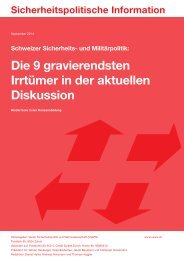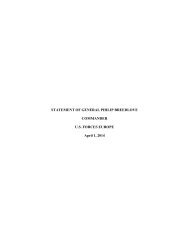FULLTEXT01
FULLTEXT01
FULLTEXT01
Create successful ePaper yourself
Turn your PDF publications into a flip-book with our unique Google optimized e-Paper software.
TACTICAL THOUGHT<br />
2014 September 29 th<br />
Result and Comments<br />
The collection of contemporary doctrines and governmental writings from USA, UK,<br />
and NATO provides the following result.<br />
The UK, NATO and U.S. 2008 writings address strategy aspects in different ways. The<br />
Swedish writing and U.S. 2008 doctrine do not directly address strategy aspects. As for<br />
aspects concerning tactics and operational art, which are linked to strategy and to each<br />
other and not always strictly separable, the Swedish, the U.S. 2008, the NATO and the<br />
UK documents do highlight such aspects (in different words) though the clearest<br />
examples are in the NATO and UK writing (Insurgency, terrorism, criminality, disorder,<br />
Guerrilla Warfare). The 2009 U.S. doctrine does not mention the same/similar or other<br />
examples.<br />
Regarding physical factors no writings address this directly. As for conceptual factors,<br />
there are quite different examples given in the Swedish document (smaller groups in<br />
network systems) compared to the 2008 U.S. writings (full range of military and other<br />
capabilities). The 2009 U.S. document does not deal with conceptual descriptions at all.<br />
Nor does the NATO document, if one can understand labels such as terrorism being<br />
tactical/operational or strategy factors. The UK paper can be seen, like the Swedish one,<br />
to provide an image of both forces, groups, and more loosely formatted or<br />
independently operating individuals within the conceptual framework. As for addressing<br />
moral factors, only the U.S. 2008 and NATO paper give guidance. They differ however<br />
regarding content, where NATO only identifies the collective will as a target for an<br />
aggressor. The U.S. paper also includes the power and the influence as targets for an<br />
aggressor.<br />
When describing “character of activity” the papers do this in different ways, from the<br />
loose UK expression of; “use of threat of force”, the NATO; “protected conflict”, the<br />
U.S. 2008; “a violent struggle”, to the Swedish and U.S. 2009 different but clearer<br />
examples such as “Guerrilla Warfare”, “Insurgency”. One can notice that the Swedish<br />
writings and NATO 2008 use the term “Guerrilla Warfare”, which the U.S. and UK do<br />
not. As for attitude aspects, no writings deal with it.<br />
All writings except the U.S. 2009 can be seen as explanatory descriptions, identifying a<br />
field of violent activities, threatening the state and striving for influence over the<br />
population. These descriptions can also be seen as umbrella explanations of different<br />
aggressions against a legitimate state from non-governmental actors. The U.S. 2009<br />
description can, on the contrary, be seen as an umbrella description also covering the<br />
defending activities for such aggressions (for example, “counterinsurgency”). This view<br />
differs from the UK, NATO and Swedish explanations, which only focus on the<br />
aggressors. As for the focus on military activities, the U.S. has a clearer focus. The other<br />
papers have more limited military focus addressing “terrorism”, “criminality”, “armed<br />
gangs”, which are usually in the area of concern for police forces. Conversely, as<br />
regards political focus on the subject of Irregular Warfare, the Swedish, NATO and UK<br />
writings express this more than the U.S. perspective.<br />
20





